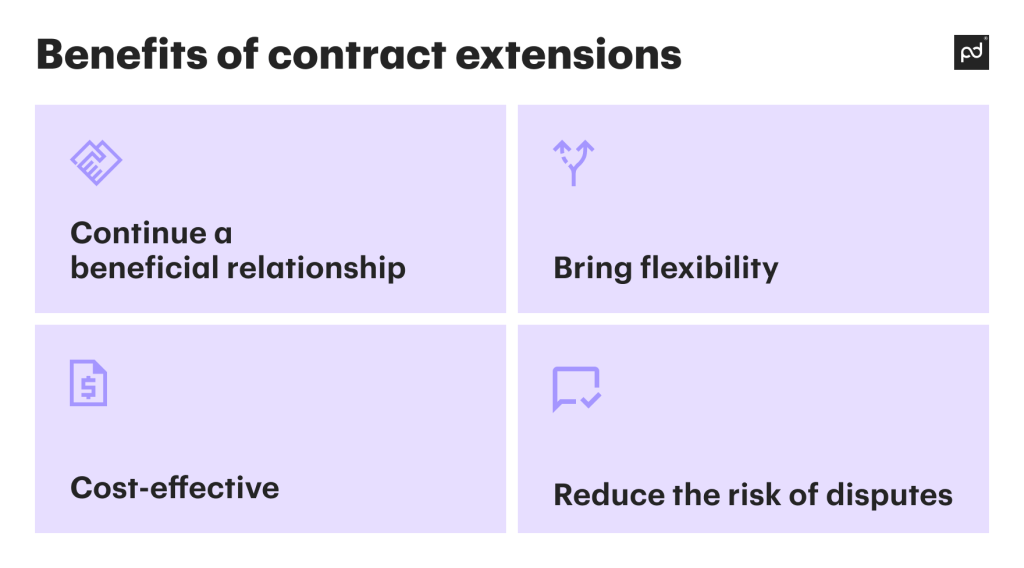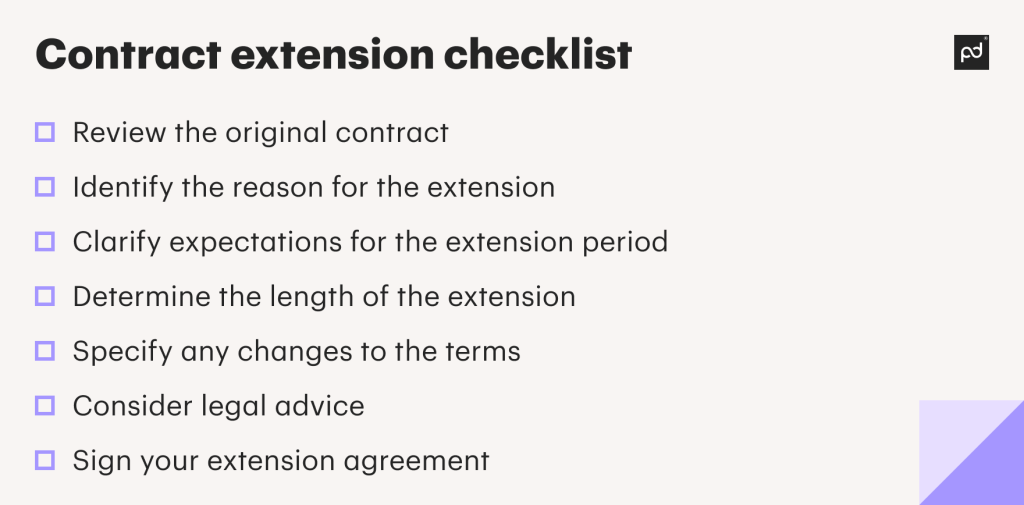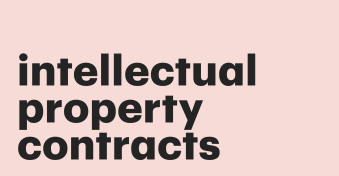They say that all good things must come to an end.
However, there are times when it simply doesn’t make any business sense to let a contract come to its scheduled conclusion.
If you want to extend the duration of a contract, a contract extension is the best way to keep moving forward with a deal that’s working for all parties.
You’ll find out exactly how you can extend your contracts and when you should use extensions right here.
What is a contract extension?
In short, a contract extension is an agreement to elongate a contract beyond its original completion date.
It doesn’t matter which industry you’re in, it’s likely that much of your day-to-day work involves contracts.
These will often describe the terms of employment for contractors to perform some services and will have a set date when the validity of the contract expires.
However, you might be approaching the end of the contract and, for whatever reason, there are still significant parts of the work to be completed.
Alternatively, your working relationship with the other party may be so productive that it would make no sense to let it come to an end simply because the original contract is approaching its end date.
In these circumstances, you’ll have a number of options.
You could always draw up a new contract with the other party.
This will allow you to make substantial changes to the original contract and could be useful if you’re setting up a completely different project for the other party to work on.
However, this will mean that you’ll have to go through all of the hard work, time, and cost that comes with writing a new contract.
Even if you use contract management software to make this process much simpler, it can still involve hefty lawyers’ fees and can take a significant amount of time.
Instead, you might want to consider negotiating a contract extension agreement.
Rather than producing an entirely new contract, this will simply amend the existing contract by pushing the date of termination further into the future.
Benefits of contract extensions
There are some obvious benefits to using an extension agreement:

1. It continues a beneficial relationship
Most contract managers use contract extensions to carry on with a successful and productive business relationship.
Compared to renegotiating a contract, using an extension will replicate most of the conditions that made that relationship a success in the first place.
2. It brings flexibility
Contract extensions are a great solution to the often inflexible world of contract negotiation.
It will allow you to respond to unpredictable events, such as weather delaying a building contract, without having to draw up a new contract.
At the same time, you can use a contract extension to easily change some of the terms of an original contract.
This flexibility can be a useful way to make changes to your business relationship.
3. It’s cost-effective
Every business should be looking for ways to reduce costs.
Extending rather than negotiating a new contract is usually a much more cost-effective solution for both parties as the expenses that come with creating a new contract are avoided.
4. It reduces the risk of disputes
If you choose to negotiate a new contract with the other party, there’s a risk that disagreements or disputes will occur.
Instead, using an extension agreement will reduce this risk while also offering the opportunity for you to clarify the terms of the original agreement.
Contract extension checklist
Before you decide to commit to an extension you should make sure that you’re best placed to make the most out of this extension.
Follow this contract extension checklist to ensure that your business uses an extension agreement effectively:

1. Review the original contract
Before you decide to extend your existing contract, you should perform a review of the original contract. This should be done alongside a performance review of your business relationship.
Make sure that the original objectives of the contract have been achieved or are on track and ensure that the costs in the contract continue to be fair and suitable to your business interests.
You should also assess the value of the contract and consider alternative arrangements.
The fact that your relationship with the other party is currently working doesn’t prevent more cost-effective solutions from being found with other contractors.
Once you’ve come to the conclusion that allowing the current contract to come to an end would be a mistake, you’re ready to start the process of arranging a contract extension.
2. Identify the reason for the extension
When you approach the contractor for an extension agreement, you’ll have to be clear about why you think it would be the right solution.
This means that you should have a simple reason for the extension.
There is usually one of two reasons for extending a contract.
You’ll either need more time to complete the terms of the contract or you’ll want to continue a strong business relationship beyond the initial terms of the contract.
Having a clear understanding of your reasons for extension will mean that everyone — including your contract management team, as well as the contractor — will be on the same page as you undergo the extension process.
3. Clarify expectations for the extension period
It’s important that you have a strong and open dialog with the other party when you’re going through a contract extension.
If the contract is coming to an end imminently, you should clarify whether work should also pause or not.
As well as this, if you envision making some wider changes to the terms of the existing contract, you should make this clear to your contractor.
Consider telling them that you don’t expect them to continue working while these changes are being made.
Determine the length of the extension
Before you place any extension length into writing, you should consult the key stakeholders in your organization.
You should also consider your reasons for extension.
If you only need to extend to finish a task, a shorter extension will be necessary.
However, a longer-term extension will allow your business relationship to continue to grow.
4. Specify any changes to the terms
A contract extension agreement will often include more changes to the terms of the existing contract than simply the termination date.
These will often include time-sensitive terms, such as delivery dates, that will be affected by an extension.
However, you might also want to make bigger changes to the terms of the agreement, such as levels of payment.
These should be clearly outlined and discussed between you and the other party before they are specified in the extension agreement.
6. Consider legal advice
Although extending a contract is simpler than producing a new contract from scratch, you should think about seeking legal advice to check the terms of your extension.
This is especially relevant if you’ve made wholesale changes to the original terms.
7. Sign your extension agreement
The final item on the contract extension checklist is to sign and date the agreement.
Once you and the contractor have signed, you’ll be able to continue working together.
How to write a contract extension letter
When it comes to actually writing the letter that will extend your contract, there are some simple guidelines that you should follow to ensure that your extension is a success.
You should begin by clearly outlining what you’re requesting and why.
Ideally, the other party will already be aware of your reasons for extending the contract but this should also be included in the contract extension letter.
As well as this, you should make sure to include all of the relevant details. These will often include:
- The duration of the extension
- Changes to responsibilities
- The terms of the contract, such as payment
- Oversight responsibilities
- Your goals and objectives
This should all be presented in a concise and formal manner, but this shouldn’t affect your relationship with the other party.
It’s important to maintain dialog with your partner throughout this process.
Once you’ve written the contract extension letter, you might want to consider using an attorney to review it.
This can ensure that your best interests are protected and you’ve fulfilled any legal obligations that you may have, as well as ensuring that there are no legal mistakes in your letter.
What’s a contract extension addendum?
Given the complexity of contract law, it can be easy to be confused by some of the language that is used when discussing contract extensions.
However, a contract extension addendum is simply the agreement that is added to the original contract to ensure that the terms of the existing contract are extended.
An addendum is essentially an addition to an existing contract.
It’s this part of the contract that ensures that you’re engaging in a contract extension rather than a complete contract renewal or a negotiation of a totally new contract.
As well as extending contracts, they can also be used to clarify parts of the existing contract or add other terms.
This means that you can use them to make wider changes that often come with a contract extension, such as changing payment dates or responsibilities.
While signing a contract extension letter is one way to confirm that a contract extension has been agreed, a contract addendum can be used if you wish to make more wide-ranging changes to the original terms of the agreement.
This means that they are often suited to larger companies or longer-duration contract extensions.
Once you’ve agreed on the scope and reasons for your extension internally and communicated this to your partner, a contract extension addendum is the final step that you’ll need to take to put the contract extension to work.
Contract extension addendum example
If you’re feeling daunted by the idea of drafting a contract extension addendum, that would be understandable.
However, there are a number of services that you can use to make this process easier.
The best way to create an effective contract extension addendum is to use a contract extensions addendum template.
As well as providing an easy-to-use and simple template that will let you produce an addendum, a template from PandaDoc can also be easily utilized alongside eSignature services.
All of this means that you’ll be able to quickly confirm your contract extension.
Keep the deal going with a contract extension
Whether you need more time to complete a construction project or you simply love working with a contractor, there are many reasons why letting an agreement run out at its contract termination date might not be the right solution for you.
While you can choose to renegotiate your contract entirely, this is often a costly and time-consuming endeavor.
Instead, it can be much easier to simply extend your existing contract.
Rather than spending weeks around the negotiating table and plunging money into lawyers’ fees, an extension agreement can let you and your partner get quickly back to work.
Two of the most common ways to agree a contract extension are through a contract extension letter and a contract extension addendum.
Using templates, it’s easier than ever to produce these agreements. Keep your productive deals going with a contract extension today!
Frequently askes questions
-
Yes, but you should make sure that these are specified and agreed with the other party.
-
Extending a contract is quite simple, but it might be useful to use a lawyer to check your agreement.
-
It’s always better to use a letter or addendum when extending a contract.
Disclaimer
PandaDoc is not a law firm, or a substitute for an attorney or law firm. This page is not intended to and does not provide legal advice. Should you have legal questions on the validity of e-signatures or digital signatures and the enforceability thereof, please consult with an attorney or law firm. Use of PandaDocs services are governed by our Terms of Use and Privacy Policy.


